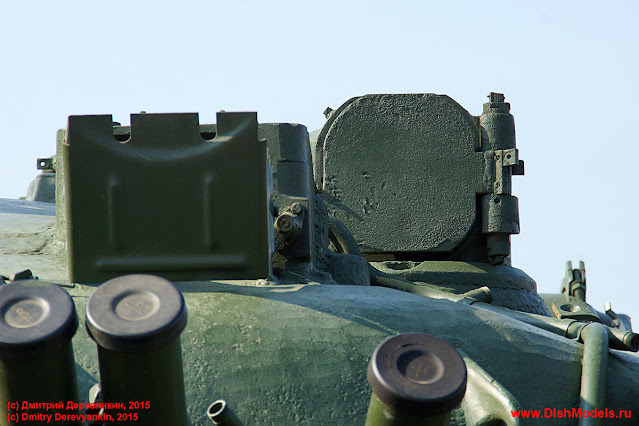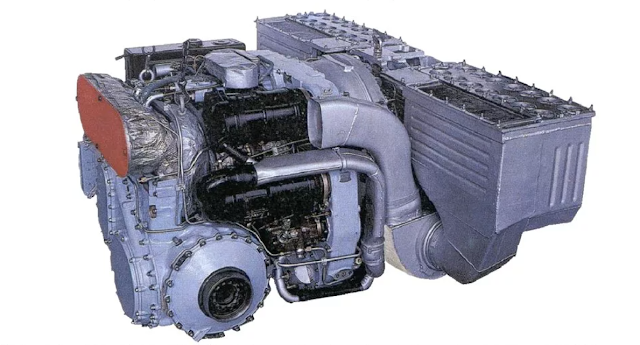Progression of thermal imaging sight housings on Soviet AFVs
Throughout the development cycle of thermal imaging sights during the Soviet Union and subsequently Russia, engineers designed several variations of covers to protect newly developed tech. Ranging from simple covers to semi/fully-mechanised systems.
The "AGAVA" series of thermal imaging sights was one of the earlier systems to be mounted on Soviet tanks dating back to the 1980s. The first sight iteration mounted on a T-80B utilized a simple protective housing with a hinge-mounted frontal cover. The front cover would be opened using a pull-string mechanism.
 |
| AGAVA on T-80B |
 |
| AGAVA on T-80B |
"AGAVA-2" made an appearance on T-80U, UM and UK tanks in the early-mid 1990s. The newer iteration still retained the same hinged door mechanism with a pull-string while also receiving a new roof cover which served as additional protection against variable weather conditions.
The last iteration of AGAVA-2 on a T-90S demonstrator was protected by a new housing and different optics cover. Lacking any mechanism to open the cover from the inside, a crewmember had to manually open the housing from the outside like on other UVZ vehicles featuring AGAVA-2
 |
| T-90S with AGAVA-2(RT) - mid-late 1990s |
The Nocturne sight, the last fully domestic Russian-produced sight at the time, which participated in the 1999 Indian tank trials, also used a bolted optics cover and a simplified housing design.
PLISA utilized the same design idea as on T-80U variants. Retaining the hinged cover design and roof cover. The main difference was that the housing was much larger, to accommodate a new optics head based on a French thermal matrix.
 |
| T-80UE-1 with PLISA TI |
From the early 2000s until the late 2010s, UVZ gradually improved the protection of their multi-channel thermal sights mounted on a variety of vehicles. The BMPT was the first vehicle to feature a partially mechanised housing cover, that utilized a spring-loaded mechanism to open the optics shutters. To prevent the shutters from opening during transportation or out-of-combat mobilization, they would be locked using a locking mechanism. It is difficult to track down the closing procedure on earlier BMPT housings.
Early BMPT multi-channel housing
The later BMPT Terminator features the same design concept, but to close the shutters, a pull-string mechanism attached to the left shutter pulls in the cover, which subsequently hooks the right shutter and closes it. A central locking mechanism prevents the covers from springing open. This housing design was later implemented on the BMPT-72.
BMPT multi-channel sight housing
In the early 2010s, UVZ implemented a general modernization program for T-72B/BA MBTs. Resulting in the installation of the Sosna-U multi-channel sight. The protection for this sight was heavily simplified by having the optics cover bolted to the main housing. This requires a crewmember to manually unbolt the cover to operate the sight. This cover design was also carried over to the T-80BVM.
Closed Sosna-U housing
Open Sosna-U housing
The T-90M being the latest UVZ MBT to go into production features a very similar housing cover as on the BMPT-72, but with minor changes. To close the shutters, 2 valve-style knobs were installed on each side of the FCS block, allowing the gunner to manually pull on the valves and activate a string pulley mechanism, which moves 2 metal plates located at the bottom of the sight. These plates push against the spring-loaded shutters and close them.
T-90M demonstration showing the housing open and close
In the end, the majority of the designs achieve partial sight mechanisation. Relying on a mechanism to open the sight covers but then utilize manual operation to close them. Other designs operate with no mechanisation and rely on a crewmember to unbolt the cover. These design choices can fluctuate depending on the allocated budget, prototype/production state or even based on simplicity and ease of use.
There are small batches of T-72B3s with custom-made housing covers, but these don't directly showcase a general design solution.
Leningrad and Omsk design bureaus have pioneered partial mechanisation in their sight covers, probably due to the lower number of procured vehicles with thermal sights at the time. While vehicles like T-72B3M and T-80BVM which make up a larger portion, rely on simpler protective means to reduce the cost to mass-produce.
Related articles:
- Soviet Union/Russian thermal sight development history
- T-90 demonstrator and its uncommon sight
- "AGAVA" - "AGAVA-2" and its confusing history
- T-90 with a promising sight returns at Army-2021
- T-72B3 tanks equipped with self-made housing covers
Taken from: BMPD.Livejournal, Dishmodels BMPT-72, Dishmodels T-80B prototype
----------------------------------------------------------------------------------------------------------------------------
----------------------------------------------------------------------------------------------------------------------------


.jpg)
.png)








Comments
Post a Comment